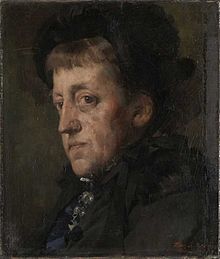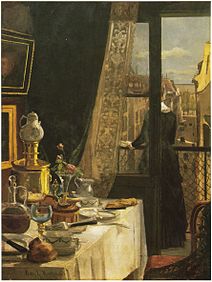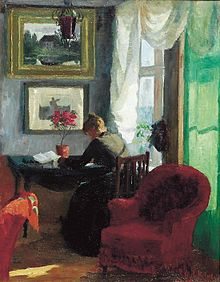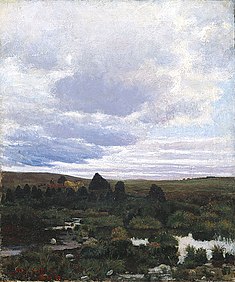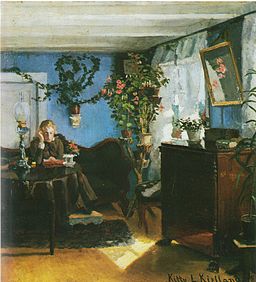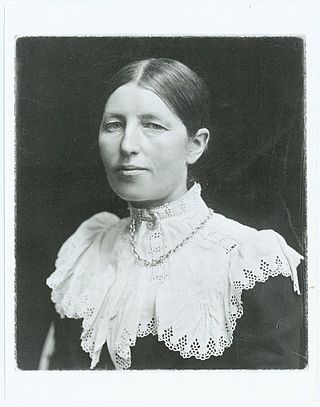
Anna Ancher was a Danish artist associated with the Skagen Painters, an artist colony on the northern point of Jylland, Denmark. She is considered to be one of Denmark's greatest visual artists.

Alexander Lange Kielland was a Norwegian realistic writer of the 19th century. He is one of the so-called "The Four Greats" of Norwegian literature, along with Henrik Ibsen, Bjørnstjerne Bjørnson and Jonas Lie.

Christian Krohg was a Norwegian naturalist painter, illustrator, author and journalist. Krohg was inspired by the realism art movement and often chose motifs from everyday life. He was the director and served as the first professor at the Norwegian Academy of Arts from 1909 to 1925.

Harriet Backer was a Norwegian painter who achieved recognition in her own time and was a pioneer among female artists both in the Nordic countries and in Europe generally. She is best known for her detailed interior scenes, communicated with rich colors and the interplay of light and shadow.

Hans Fredrik Gude was a Norwegian romanticist painter and is considered along with Johan Christian Dahl to be one of Norway's foremost landscape painters. He has been called a mainstay of Norwegian National Romanticism. He is associated with the Düsseldorf school of painting.

Frits Thaulow was a Norwegian Impressionist painter, best known for his naturalistic depictions of landscape.

Otto Ludvig Sinding was a Norwegian painter, illustrator, poet and dramatist. Sinding drew on motives from Norwegian nature, folk life and history.
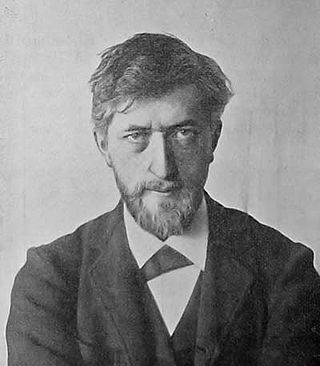
Jens Ferdinand Willumsen was a Danish painter, sculptor, graphic artist, architect and photographer. He became associated with the movements of Symbolism and Expressionism.
Olaf Helliesen Lange was a Norwegian painter and print maker. Lange's fin-de-siècle art has its own special approach visualizing the complexity of the modern urban life.

Sandviksfjorden is a painting by Norwegian romanticist painter Hans Gude completed in 1879.
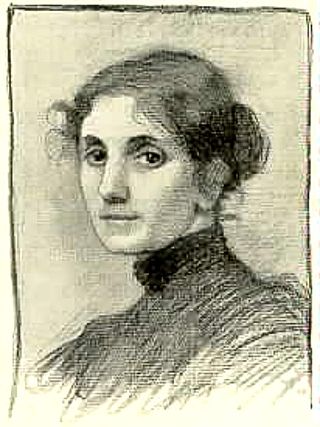
Marianne Stokes was an Austrian painter. She settled in England after her marriage to Adrian Scott Stokes (1854–1935), the landscape painter, whom she had met in Pont-Aven. Stokes was considered one of the leading women artists in Victorian England.

Nils Severin Lynge Hansteen was a Norwegian painter. He was known principally for his landscape painting as well as his marine art, often featuring ships in a stormy seas.

For much of its history Norwegian art is usually considered as part of the wider Nordic art of Scandinavia. It has, especially since about 1100 AD, been strongly influenced by wider trends in European art. After World War II, the influence of the United States strengthened substantially. Due to generous art subsidies, contemporary Norwegian art has a high production per capita.

Hjalmar Eilif Emanuel Peterssen was a Norwegian painter. He is most commonly associated with his landscapes and portraits. He gained early recognition for the history painting Christian II signing the Death Warrant of Torben Oxe and established himself as one of Norway's foremost portrait painters, with portraits of, among others, Henrik Ibsen and Edvard Grieg. He also became known for his landscape paintings, and became part of the artist circle known as the Skagen Painters. He also became known for his design in 1905 of Norway's national coat of arms with the Norwegian lion, which was used by the government and the royal house. The design is still used in the royal coat of arms and the royal flag.

The Skagen Painters were a group of Scandinavian artists who gathered in the village of Skagen, the northernmost part of Denmark, from the late 1870s until the turn of the century. Skagen was a summer destination whose scenic nature, local milieu and social community attracted northern artists to paint en plein air, emulating the French Impressionists—though members of the Skagen colony were also influenced by Realist movements such as the Barbizon school. They broke away from the rather rigid traditions of the Royal Danish Academy of Fine Arts and the Royal Swedish Academy of Arts, espousing the latest trends that they had learned in Paris. Among the group were Anna and Michael Ancher, Peder Severin Krøyer, Holger Drachmann, Karl Madsen, Laurits Tuxen, Marie Krøyer, Carl Locher, Viggo Johansen and Thorvald Niss from Denmark, Oscar Björck and Johan Krouthén from Sweden, and Christian Krohg and Eilif Peterssen from Norway. The group gathered together regularly at the Brøndums Hotel.

Ludvig Karsten was a Norwegian painter. He was a neo-impressionist influenced by Edvard Munch, Henri Matisse and contemporary French painting. He first participated at the Autumn exhibition in Kristiania in 1901, and had his first separate exhibition in 1904. He is represented at museums in many Scandinavian cities, including several paintings at the National Gallery of Norway. Karsten was known for his bohemian lifestyle and quick temper.

Suzette Catherine Holten was a Danish painter and ceramist who belonged to the Skovgaard family of artists. In addition to landscapes, flower paintings and portraits, she created and decorated ceramics and also worked as an embroiderer. As a woman, she was unable to achieve the same level of acclaim as her father or brothers.

Bridal Procession on the Hardanger is an 1848 oil painting by Hans Gude and Adolph Tidemand. Gude, aged just 23, painted the landscapes and Tidemand, a decade his senior, the bridal party. Each of the Norwegian artists had studied at the Kunstakademie Düsseldorf before they first met in Hardanger in 1843, and the painting was made in the winter of 1847–1848 in Düsseldorf. It measures 93 cm × 130 cm and has been held by the National Gallery in Oslo since 1895. It is one of the best known Norwegian paintings, and is considered to be an excellent example of romantic nationalism in Norway, combining a romanticised landscape with traditions of Norwegian life.
Helene Marie Stromeyer was a German painter known for her floral and landscape paintings.
